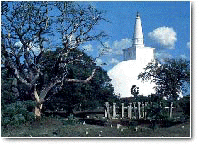Wherever you go, you will
find the traditional welcome -"Ayubowan"-
may you live long
CITY OF ANURADHAPURA
 |
205 km from Colombo is Anuradhapura, Sri Lanka's first capital founded about the 4th century BC. According to the Mahavansa, the Sinhala Buddhist chronicle, the city was a model of planning. Precincts were set aside for huntsmen and scavengers and even heretics and foreigners. There were hostels and hospitals, separate cemeteries for high and low castes. A water supply was assured by the construction of reservoirs. In this time Anuradhapura was the greatest city in the island. Its ruins display the infinite details of rare beauty, delicately set in the world's masses of monumental masonry, second only to the pyramids of Egypt. |
Anuradhapura remained the capital of Sri Lanka for 1400 years. Anuradhapura was to continue for six hundred years as the national capital. But internecine struggles for the royal succession grew, and it became more and more vulnerable to the pressures of South Indian political expansion. The city was finally abandoned and the capital withdrawn to more secluded areas.

The sacred bo tree; Sri Maha Bodi, which was grown from the branch
of the very tree under which Lord Buddha found enlightenment is positioned
at the heart of the town of Anuradhapura. It is one of the relics of
living splendor. It is been attended, generation after generation to this
day, in short for 23 centuries. This is the oldest documented tree on
earth.
When heading to the north of Anuradapura one would encounter Ruwanwaly
Saya the 'great stupa' raised in the second century B.C and
which is regarded the greatest structure in the city. Today the gatehouses
at each of the four cardinal points mark the dagoba's outer wall of the
original structure.
There are some remarkable structures around these premises. Thuparama
dagaba is the oldest in the island and it is believed to enshrine the
Collabone Relic of the Buddha. Being one of the highest [and concealed by
lushes of trees] Giant, Jetavanarama sparkles with it individual
power.
Lowa Maha Paya is said to be an old monastery of nine stories and
1000 rooms adorned with silver and gems.
Kuttam Pokuna,or the twin ponds is an archaeologically perfect bathing pool for the monks, opposite the monastery of Uttararaviharaya. The water that feeds the ponds flows first into an enclosed filtration basin, then through a beautiful makara gargoyle and lion's head spout into the smaller tank.
Samadhi Pilimayais a lime stone image, which depicts the Buddha in the serene state of meditation and Aukana Pilimaya , is undoubtedly the most magnificent undamaged ancient image in the island.
At the southern end of the Royal Pleasure Garden, Isurumuniya, is a group of three ponds, two of which are decorated with lovely bas-reliefs of elephants playing with the water lilies.
The rock carving
'the lovers' stands opposite the pond and it's intricate detailed
skills marvels the eye of an architect. Present architects are amazed by
the ancient technology used in the lakes that span the capital.